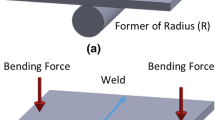Abstract
Cracking of Inconel Alloy 600 (registered trademark) u-bend tubes used in pressure-water-reactor (PWR) steam generators has been a major concern in the nuclear-power industry over the past several years. The mechanism of cracking has been determined to be intergranular stress-corrosion cracking with residual stresses a major contributor. A simple specimen known as a reverse u-bend (RUB) has been used by a number of laboratories to simulate the high stresses and plastic strain extant in the most susceptible regions of the u-bend tubes. This paper presents the results of residual-stress measurements on four RUB samples, each from a different laboratory.
The results indicate that the individual RUB fabrication procedures used by different laboratories tend to produce different residual-stress patterns in the highly strained regions over 700 tensile to nearly 700-MPa compressive on different samples. Stress gradients on the order of 140 MPa/mm were found on some samples. The residual-stress patterns were seen to qualitatively predict the stress-corrosion-cracking pattern experienced on similar samples.
Similar content being viewed by others
References
Aspden, R.G., Carter, J.W. and Morgan, L.P., “Cracking of Inconel 600 Steam Generator U-Bends from the Primary Side,” Paper No. 206, Corrosion 82, Houston, TX. Paper available from National Association of Corrosion Engineers, Houston, TX.
Garud, Y.S. and Gerber, T.L., “Intergranular Stress Corrosion Cracking of Ni-Cr-Fe Alloy 600 Tubes in PWR Primary Water—Review and Assessment of Model Development”, EPRI Project S138-8 (May 1983).
Bandy, R. and van Rooyen, D., “Stress Corrosion Cracking of Inconel Alloy 600 in High Temperature Water—An Update,” Corrosion '83, presented at the International Corrosion Forum, Annaheim, CA (April 1983).
Yashima, S. and Uragami, K., “Studies of Steam Generator U-Tubes Affecting Stress Corrosion Cracking”, ASME, Paper No. 82-NE-5.
Cloud, R., Lueng, J. and Loey, H., “Elastic Stress Analysis of Small-Radius U-Bend Steam Generator Tubes,” EPRI Project S194-4, NP-2944 (March 1983).
Economy, G., Jacko, R.J. andPement, F.W., “IGSCC Behavior of Alloy 600 Steam Generator Tubing in Water or Steam Tests above 360°C,”CORROSION/86, Paper No. 250, NACE, Houston, TX (1968).
Johnson, A.B., Jr., and Bickford, R.L., “Steam Generator U-Bend Tube Examination,” EPRI Project S138-5, NP-3571-LD (July 1984).
Ivkovich, D.P., Ruud, C.O. andSnoha, D.J., “Residual Stress Measurements in Inconel Alloy 600 Tubing Using an Advanced X-Ray Instrument and Cr K-Beta Radiation, Adv. in X-Ray Anal.,28,275–279,Plenum Press (1985).
Ruud, C.O., DiMascio, P.S. andSnoha, D.J., “A Miniature Instrument for Residual Stress Measurement,”Adv. in X-Ray Anal., Plenum Press,27,273–283 (1984).
Ruud, C.O., “Position-Sensitive Detector Improves X-Ray Powder Diffraction,” Ind. Res. and Dev., 84–87 (Jan. 1983).
Cullity, B.D., “Some Problems in X-Ray Stress Mexsurements,”Adv. in X-ray Anal.,20,259–271,Plenum Press (1976).
Brackman, C.M., “Residual Stresses in Cubic Materials with Orthorhombic or Monoclinic Specimen Symmetry: Influence of Texture on Psi Splitting and Non-linear Behavior,”J. Appl. Cryst.,16,325–340 (Jan. 1983).
Prevey, P.S., “A Method of Determining the Elastic Properties of Alloys in Selected Crystallographic Direction for X-Ray Diffraction Residual Stress Measurement,”Adv. in X-Ray Anal.,20,345–354 (1977).
Ruud, C.O., Snoha, D.J. and Ivkovich, D.P., “Experimental Methods for Determination of Precision and Accuracy in XRD Residual Stress Measurement,” Adv. in X-Ray Anal.,30 (1987).
SAE, Residual Stress Measurement by X-Ray Diffraction-SAE J784a.Soc. of Auto. Engr., 400 Commonwealth Dr., Warrendale, PA (1971).
ASM, Source Book on Industrial Alloy and Engineering Data, The Amer. Soc. for Metals, Metals Park, OH, 313 (Feb.1978).
Takemoto, M., “Study on the Failure Threshold Stress Criteria for the Prevention and Mechanism of Stress Corrosion Cracking,” to be published.
Ruud, C.O., andIvkovich, D.P., “Residual and Applied Stress Analysis of an Alloy 600 Row 1 U-Bend,”EPRI Final Report NP-5282, Research Project 5303-3, Elec. Power Res. Inst., Palo Alto, CA (Sept.1987).
Author information
Authors and Affiliations
Additional information
Electric Power Research Institute.
Rights and permissions
About this article
Cite this article
Ruud, C.O., Snoha, D.J. & Mcllree, A.R. Residual stresses in reverse-bend test samples for stress-corrosion testing. Experimental Mechanics 29, 54–57 (1989). https://doi.org/10.1007/BF02327781
Received:
Accepted:
Issue Date:
DOI: https://doi.org/10.1007/BF02327781




